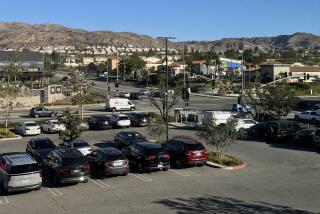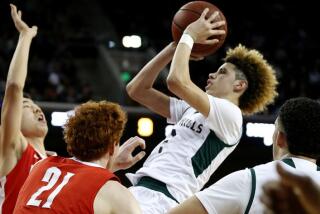Puck Problems : Roller Hockey’s the Rage, but Finding a Place to Play Can Be Tough
- Share via
The Nordiques and the Panthers were on the run.
First they were booted from a shopping mall parking lot in West Hills. Then they got kicked out of an elementary school. And it was all because neighbors complained that the roller hockey teams made too much noise when the pucks hit the boards, or when their skates clattered across the asphalt, or when exuberant parents shouted too loudly.
Eventually, after they were chased outside the Los Angeles city limits, the players, ages 8 to 13, found a third site for practice games: a Calabasas elementary school.
The saga of the Nordiques and the Panthers is not unusual. Roller hockey is the new youth sport rage in Southern California, with many kids setting aside baseballs and basketballs and creating hockey hotbeds in communities from Los Angeles to Orange County.
But as the sport’s popularity continues to grow, so does the number of school districts or businesses banning the activity because they don’t want to be held liable if players get hurt, even though most, if not all, organized leagues have insurance. The Los Angeles Unified School District is among those that has prohibited the sport on its campuses.
“We don’t have designed areas that are safe to play,” said Jim Sugahara, head of outdoor recreation programs for the giant district.
“The grounds have a lot of cracks, and children may run into basketball poles,” he said. “It’s not conducive to roller-skating or roller-blading. It’s just not designed for that purpose.”
But parents and coaches who have seen children abandon Little League baseball and other established sports to play roller hockey disagree.
“That’s just excuses,” said Steve Shepp, a coach for the Nordiques.
“They don’t need much other than a blacktop,” he said, adding that all players in his league are required to wear proper equipment and that all the games are supervised.
But fear of lawsuits has prompted schools and businesses--places with big parking lots--to put a damper on the popular pastime.
“Our security people on weekends have chased some kids and young adults off of our school sites,” said Brad Lantz, student services director for the Tustin Unified School District in Orange County.
These are growing pains being felt throughout the region as pint-size Wayne Gretzkys pour out of neighborhood cul-de-sac pickup games, looking for organized teams and places to play.
The Nordiques and Panthers, two teams from the West Valley Roller Hockey League, have missed a total of about three weeks of practice since the season began in late March; they have twice lost their playing privileges when neighbors and school officials complained of noise, heavy traffic and the destruction of property.
“Once or twice a puck went through a school window. However, they did replace them,” said Ilene Meyers, principal of Lockhurst Drive Elementary School in Woodland Hills. After a six-month tryout, she decided not to allow the West Valley league to practice on her playgrounds.
“It just didn’t work out,” said Meyers. “Our school is in a residential neighborhood. It was difficult for people living there.”
The coaches got on the phones again and called more churches and private businesses with big parking lots. But the answer was always no, with the same concerns cited, said Pete Hogenson, the Panthers’ coach.
“We couldn’t hold practice for about two weeks because we didn’t have a practice site,” said Hogenson, whose 8-year-old son, Jake, plays on the team. “We didn’t want to take these kids to go and practice at somebody’s abandoned parking lot without permission.”
Finally, Chaparral Elementary School in Calabasas agreed to allow the teams to practice twice a week for a total of three hours. The players and coaches couldn’t be happier.
One of the few places in Southern California where young roller hockey players get a welcome is Side by Side Rinks in Huntington Beach. League play goes on 23 hours a day, seven days a week. Players show up at 1 a.m. for the final set of league games.
At 4 a.m., the rink shuts down--for an hour. At 5 a.m., the next day of roller hockey begins.
But the search for less formal practice sites has posed a minor law enforcement problem, as police officers encounter weekend hockey games on school property and force the players to clear out.
“The police come out and tell us to leave, the principals come out and tell us to leave; I think it’s really stupid,” said Brian Fletcher, 17, who plays for a junior team in Mission Viejo. For Fletcher, “roller hockey is the best sport in the world. You get going so fast, you get so much speed, it’s kind of a rush. Then when you score a goal, and you get really pumped.”
The popularity of youth roller hockey was made possible by two events, enthusiasts agree: The successful marketing of in-line skates--with a series of wheels set in a single line between the heel and toe--and the celebrity of Los Angeles Kings superstar Gretzky.
While the problem with playing sites centers on schools, some cities are also concerned enough about liability to take a hard line.
Alan Trudell, a spokesman for the Garden Grove Unified School District, said his 9-year-old son and his friends have been shooed away from parks by city employees in Anaheim Hills. “It’s really overpowering my son’s desire to play football or baseball. He loves to play roller hockey.”
John Black, who managed Roller Hockey International’s Los Angeles Blades franchise last year, also organizes youth roller hockey tournaments throughout Southern California and has seen the phenomenal growth of the game.
“You can see the gleam in a kid’s eyes when they talk hockey,” he said. “The word you hear over and over is addictive. This sport has really taken root, and it’s definitely here to stay.”
Black and other roller hockey organizers say the only thing holding the game back is lack of proper facilities.
“We have organized baseball, basketball and soccer. Why can’t we have organized roller hockey?” said Panthers coach Hogenson. “I’d like to see it be a part of city parks and recreation programs.”
With schools conveniently located in most neighborhoods, most roller hockey players wind up in the schoolyard. A better way needs to be found, everyone agrees, but progress toward developing roller hockey facilities has been slow.
The problem of finding a place to play, though increasingly common, is not new. George Williams, 34, owner of the Reseda Roller Hockey League, recalls that even before the era of in-line skates--when he and his young Burbank buddies wore sneakers to play street hockey--the sport was not a big hit with authority figures.
“We’ve been kicked out of every schoolyard, every tennis court and every supermarket parking lot,” Williams said. “We knew every cop in Burbank by name.”


